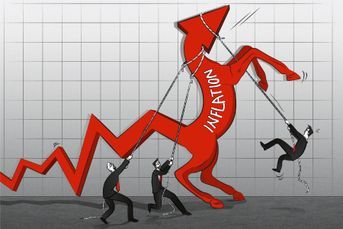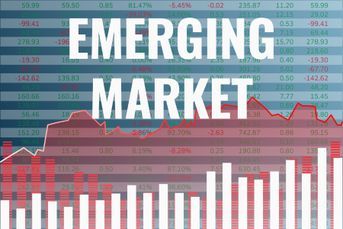ETFs may become preferred way to speculate on junk bonds
Exchange-traded funds are poised to overtake credit derivatives by year-end as a way to speculate on junk bonds.
Exchange-traded funds are poised to overtake credit derivatives by year-end as a way to speculate on junk bonds.
The value of corporate securities held by the five largest junk ETFs almost doubled in the past year to a record $31.4 billion, while the net amount of protection bought or sold on the debt using the two current credit-default-swaps indexes declined 3% to $35 billion, data compiled by Bloomberg show. The ETFs are growing this year at an average monthly pace of 5.2%, which would put assets at more than $36.5 billion by Dec. 31.
Trading in credit swaps has slowed as the market for them faces regulation for the first time under the Dodd-Frank Act, potentially making them harder and costlier to buy and sell. The growth of junk bond ETFs, which are listed on exchanges and brokered like stocks, has accelerated since their inception in 2007 as investors seek a faster and cheaper way to trade debt.
“Product innovation is often the answer to regulatory change, and I don't think it's any coincidence that we've seen this explosion of interest in fixed-income ETFs just at the point at which CDS as a product and asset class comes under pressure,” said Will Rhode, director of fixed income at research firm Tabb Group LLC.
GAINING INFLUENCE
Junk bond ETFs, which have attracted 25% of high-yield-fund inflows since 2010 as measured by EPFR Global, are gaining influence in a market where both the securities and their derivatives generally are traded off exchanges.
Even investors seeking to hedge against losses on the securities have started using ETFs, with the number of shares borrowed to bet against one run by State Street Corp. surging almost threefold from the end of last year.
Credit swaps, created in the 1990s as a way to allow lenders to protect against losses on corporate debt, gained popularity over the past decade as a way to wager on gains without actually owning bonds or loans.
With the Federal Reserve saying last month that it will probably hold its interest rate target near zero through at least mid-2015 and conduct a third round of bond purchases to stimulate the economy, investors are gravitating toward the funds to boost returns as demand for default protection diminishes.
NORDEA, GETTY
Elsewhere in credit markets, Nordea Bank AB, the Nordic region's largest lender, is planning its first offering in more than 16 months of dollar-denominated 10-year bonds.
Getty Images Inc., the photo archive, is said to be seeking $1.85 billion in loans to back its buyout by The Carlyle Group LP.
The Markit CDX North America Investment-Grade Index, a credit swaps benchmark tied to the debt of 125 companies in Canada and the United States, has been at around 83 basis points, the lowest level since March 2011.
The Markit iTraxx Europe Index of 125 companies with investment-grade debt is around 120.
The indexes typically rise as investor confidence deteriorates and fall as it improves. Credit swaps pay the buyer face value if a borrower fails to meet its obligations, less the value of the defaulted debt.
A basis point equals $1,000 annually on a contract protecting $10 million.
Getty's financing will include a $1.7 billion term loan and a $150 million revolving line of credit, according to a person with knowledge of the transaction, who asked not to be identified, as the information is private.
“MEANT TO WORK’
Trading volumes in the current version of the Markit CDX high-yield-credit-swaps index have declined about 20.2% from last year, when an escalating European debt crisis sent debt investors rushing to protect against losses, Barclays analysts led by Bradley Rogoff wrote in a Sept. 14 report.
The firm cited data from the Depository Trust & Clearing Corp., which runs a central credit swaps repository.
The declines, they said, have resulted in part from regulations being written to comply with the 2010 Dodd-Frank Act, which will require most swaps to be processed by clearinghouses and traded on exchanges or electronic systems.
The new rules were put in place to guard against a repeat of 2008, when the contracts complicated efforts to resolve the financial crisis. They will increase costs for both banks and money managers in the market.
“This is the way in which financial markets are meant to work — adapt to change through innovation,” Mr. Rhode said.
CDS DISAPPOINTMENT
ETFs may eclipse credit swaps indexes in debt markets in part because many traditional money managers never fully embraced the derivatives, according to Peter Tchir, founder of macro strategy firm TF Market Advisors.
“They've always looked for an alternative and been really disappointed with CDS,” he said.
ETF assets and shares outstanding have surged at the same time that dealer inventories of the underlying bonds have shrunk to the lowest in more than a decade, making it more difficult for money managers to trade the debt.
Holdings of corporate securities by the 21 primary dealers that trade directly with the Fed had shrunk 81% to $43.8 billion as of Sept. 5, from a peak of $235 billion in 2007, according to data from the central bank.
PITCHED “A LOT’
“I've definitely had it pitched to me a lot” as an alternative to holding cash reserves, Nancy Davis, director of derivatives at AllianceBernstein LP, which manages $230 billion in fixed-income assets, said of high-yield-bond ETFs.
The funds are more appealing than credit swaps to investment firms that haven't set up legal protocols to trade the privately negotiated contracts with banks or are restricted from trading the derivatives, she said.
“They either have cash positions or they're completely invested in cash bonds, which aren't always very liquid,” Ms. Davis said.
Junk bond investors have been emboldened by default rates below historical averages.
The global speculative-grade default rate as measured by Moody's Investors Service was 3% in August, up from 1.8% a year earlier, according to a Sept. 10 report. That compares with a historic average of 4.8% in Moody's data going back to 1983.
“REMARKABLY STEADY’
“The rate of default has remained remarkably steady,” Albert Metz, managing director of Moody's Credit Policy Research, wrote in the report.
“As credit spreads continue to narrow slightly, our forecast remains fairly benign” at 3.1% by year-end and 3% in August 2013, he wrote.
For investors not sold on the junk bond rally, ETFs also provide an alternative for betting against the market. The shares are easier to borrow than corporate bonds for use in short sales, in which traders sell borrowed stock in a bet they can profit from price declines.
The number of borrowed shares of State Street's SPDR Barclays Capital High Yield Bond ETF (JNK) climbed to a record 13.1 million on Aug. 30, from 4.75 million at the end of last year, according to Markit Group Ltd. The amount eased to 6.76 million Sept. 12 as speculation the Fed would unleash another round of stimulus caused bearish investors to reverse bets.
Corporate holdings in the ETF, the second-largest of its kind, climbed 43% this year to $12.7 billion, with the fund returning 11.2%, Bloomberg data show.
Holdings in BlackRock Inc.'s iShares iBoxx High Yield Corporate Bond Fund (HGY) surged 60% to $17 billion, returning 9.9% this year. That compares with average gains of 12.6% in Bank of America Merrill Lynch's U.S. High Yield Master II Index.
LONDON WHALE
Investors seeking a hedge against junk bond losses also were pushed to ETFs this year after trades by a JPMorgan Chase & Co. trader distorted prices in credit swaps indexes.
Bruno Iksil, who became known as the London Whale because the size of his bets grew so large, fueled price disparities between the derivatives benchmarks and the price of contracts on companies within the indexes, market participants familiar with the trades said at the time.
Such dislocations unique to credit derivatives may scare away investors, according to Stephen Antczak, Citigroup Inc.'s head of U.S. credit strategy.
“When you're seeing big divergences in indexes from their constituents, maybe that's being driven by someone who's not a credit investor — maybe it's an equity guy,” he said.
“That's what worries people. Those indices can get whippy [and it's] not necessarily driven by cash corporate bonds,” Mr. Antczak said.
Learn more about reprints and licensing for this article.







